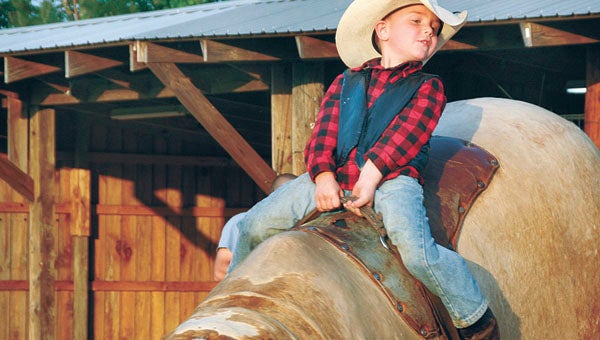How to speak ‘rodeo’
Published 10:40 pm Tuesday, May 8, 2012

This young cowboy tests his skills on a mechanical bull, one of the “sideshows” at the annual Gates County Rodeo
By Cal Bryant
Special to the News-Herald
You’ve undoubtedly heard the old saying, “Hey, this ain’t my first rodeo.”
Most of the time when people say it, they’re not referring to an actual rodeo. But this weekend they could be. If it were, indeed, your very first time at a rodeo, would you know what to expect?
Call us “greenhorns” if you will, but we are a little inexperienced when it comes to knowing exactly what we’re seeing in a rodeo ring.
Thank goodness Aaron Brown has the answers for all of us rodeo novices of the world. Brown, who for the 15th year will host the Gates County Championship Rodeo at his Roping Arena on the Paige Riddick Road, offered us an insider’s glimpse of what to expect.
To start with, fans will witness such events as bareback bronc riding, saddle bronc riding, calf roping, steer wrestling, team roping, cowgirls’ barrel racing, breakaway roping and wild bull riding.
Roping events require agility, timing, speed, strength and a highly trained horse. During the calf-roping event, a calf is released, and the cowboy must rope it as quickly as possible.
Team roping involves one roper known as the “header” and one roper known as the “heeler.” The header ropes the steer’s horns, wraps the rope around the saddle horn and then turns the steer so the heeler can wrap the animal’s hind legs.
During the calf-roping events, the cowboy dismounts after making the catch, sprints to the calf and tosses it on its side, which is called flanking. With a small rope known as a pigging string, any three of the calf’s legs are tied securely. Time stops when the cowboy throws up his hands.
Events like saddle bronc riding grew out of ranch cowboys breaking wild horses to use as working cow horses. Modern saddle bronc riding is similar, with only a few modifications, mainly in equipment. Bareback and bull riding relies more on strength, while saddle bronc riding relies more on timing, finesse and skill.
Steer wrestling is one of the most spectacular rodeo events and demands strength, courage and determination. The cowboy must jump from the back of a running horse onto the back of a steer that weighs up to 700 pounds and wrestle the animal to the ground.
There are also cowgirls competing for prizes. Barrel racing is their “thing” at the rodeo. Barrels are placed at three points inside the arena. The riders, their horses entering the arena at a full gallop, maneuver their four-legged rides around the barrels and exit the arena at the same point of entry. The rider with the best time from start to finish (without knocking over any of the three barrels) is declared the winner.
The nightly finale is the bull riding event. These brave men strap on for the ride of their lives aboard a mean, ornery 2,000-pound bull with just one thing on his mind — knock off whoever is along for the ride. All a rider has to do to score points is hang on for eight seconds, but that’s easier said than done.
Brown, who started the rodeo 15 years ago, said he really enjoys putting on the event. He added that he is amazed at the community support generated by the annual event.
Brown spends months planning the event, and his family from Pennsylvania comes to help put on the show. He hires clowns, brings in sound equipment, sets up bleachers, mows the surrounding fields and organizes everyone involved.
A stock contractor provides the broncs, barebacks and bulls for the events, including 2,000-pound bucking bulls. Meanwhile, the riders compete for thousands of dollars in prize money and fight for points in their season-long competition.
The event is sanctioned by the Southern Rodeo Association and the American Pro Rodeo Association.


